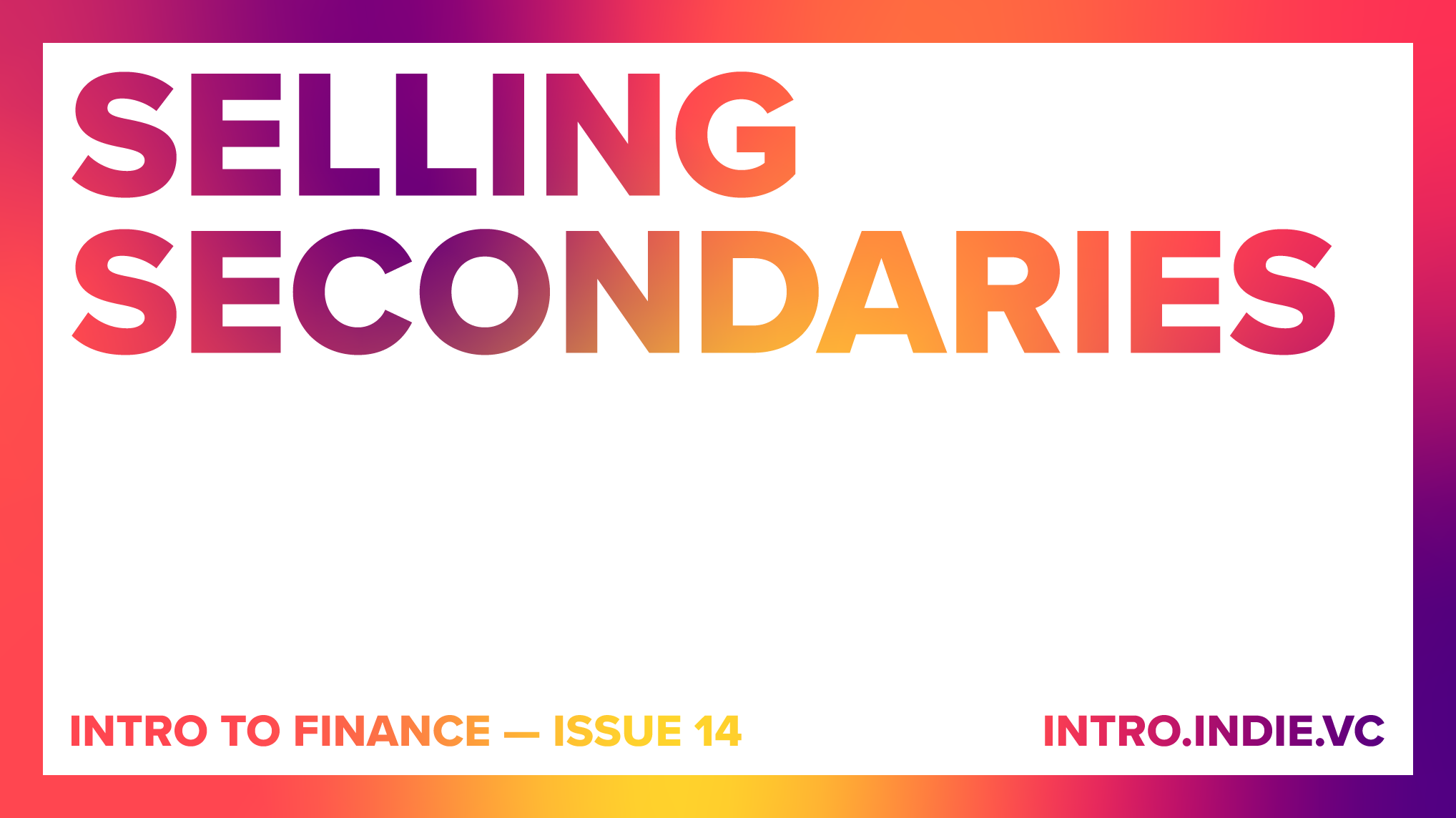Selling Secondaries
Hello everyone, this is Jason. Welcome back to INTRO to Finance – the newsletter that takes your burning financial questions and quenches them with easily digestible and actionable answers.
But first — a quick update.
It’s been a wild week since launching INTRO. We had thousands of people on INTRO last week with nearly 1,000 accounts created. Of the companies that best fit our partner network (US or Canada-based with more than $10k in monthly revenue), ~90% had a funding option available to them upon completing their profile. Over the coming weeks, we’ll keep adding more partners and financial products to our network to deliver on the promise of a continuous stream of non-dilutive funding options for INTRO users.
To everyone who created an INTRO profile, thank you! We hope the process was painless, eye-opening, and a game-changer to how you think about accessing capital. Please let us know what else we can be doing for you.
If you haven’t created your INTRO profile, what’re you waiting for?!
Now back to our regularly scheduled INTRO to Finance. This week we’ll be answering:
“How do I fund payouts to existing shareholders before an exit?”
Today’s question takes us to a different type of equity financing from typical Venture Capital investments - Secondary transactions.
We’ve received this question in many forms and for a variety of different circumstances. Though the motivation to provide a payout to your shareholders can vary widely, the mechanics are fairly similar.
The Basics
Let’s start with an analogy:
You’ve likely heard CEOs should focus on having “the right people on the bus”. Usually that refers to your management team and employees. But shareholders are passengers on this bus, too. In general, shareholders get on the bus with a destination and ETA in mind. There might have been alignment when you brought them on board, but, as with most things in startups and life, things change.
This is where Secondary transactions come in.
Secondary transactions allow you to let certain shareholders off the bus when they want to get off. They also allow you to bring on new shareholders who are happy to ride to your next destination and arrive at the same time as you.
The process is still an equity investment and has a similar process to VC. The financier will be assigning a value and making an offer to purchase shares in your business. However, the outcome is vastly different from your typical primary equity raise, where the new capital goes to operations of the business.
With Secondaries, the company doesn’t receive any of the money in the financing. Instead, the money is received by an existing shareholder in exchange for the shares they have in your business.
The best part of these equity transactions is that you keep shareholders happy without introducing dilution or loss of ownership to yourself or any other shareholder in your business.
How this Differs from Primary Equity Investments
Beyond where the cash is sent, there are differences between secondary and primary equity transactions.
The first difference is the discount. With secondary transactions, there’s generally a 20-30% discount to the value that you’d see in a primary equity round. The discount is there because the investor can’t sell the shares as easily as they could with publicly-traded company shares. There may also be new shareholders in the business who sit higher in the Capital Stack.
Another distinction is the Right of First Refusal (ROFR). Existing investors often have a contractual Right of First Refusal that gives them the right to meet or beat any price before selling shares to an outside investor in a secondary transaction. Your company counsel could tell you whether this applies to your business, and describe the mechanics of how it works.
Who Does This
Here are some ways you can pursue a secondary transaction:
Equity Investors Investing in your Business
Example: The lead investor in your Series A round of funding.
Pros:
You’re in the process of bringing in new investors and completing the diligence process.
The investors already have an interest in owning stock in your business and may want to own more.
Cons:
Working with a shareholder who wants to sell could add additional workload to completing the primary equity raise.
Secondary Exchange Marketplaces
Example: CartaX
Pros:
A marketplace that provides a highly-efficient way to connect shareholders with potential buyers.
The platforms serve as a “clearinghouse” and manage many of the manual parts of a secondary transaction.
Cons:
Founders and CEOs may not have control or visibility of who ends up owning the shares.
Secondary Investment Firms
Example: Delta-v Capital
Pros:
Allows for a two-way relationship between management teams and prospective investors to get to know each other well.
The firm will negotiate the price with your shareholders to purchase their shares.
Cons:
This is still an equity process and can take up some of your time. (Usually faster than a primary raise given the nature of the transaction)
If you have shareholders, you have expectations around liquidity to manage. Some will be fine with extended timelines, but many will not.
Think back to the earlier bus analogy: most people board a bus with the expectation they’ll disembark at some point. Your shareholders – whether they’re friends, family, former employees, or venture capitalists – made a similar assumption before hopping on your bus. Check in with them to see if they’re happy with the ride, or if they’d like to hop off at the next stop via a Secondary transaction.
Understanding your Secondary financing options will keep you focused on your destination instead of being distracted by misaligned shareholders.


